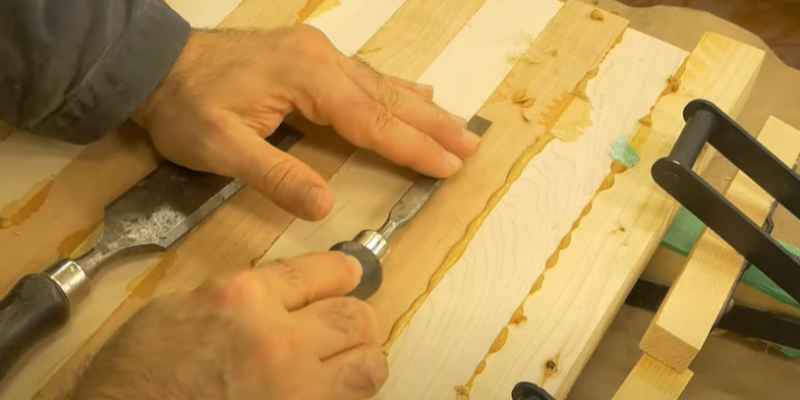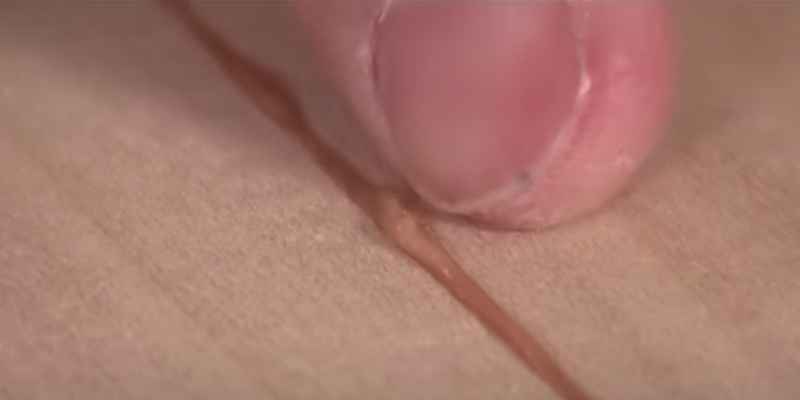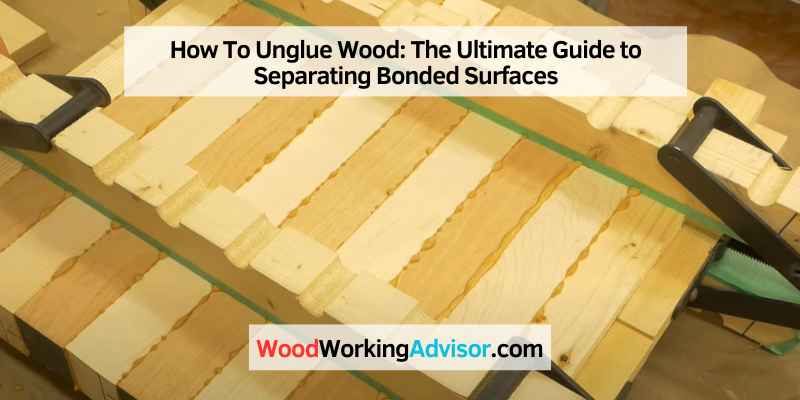To unglue wood, you can use a combination of heat and a putty knife to soften the adhesive and carefully separate the pieces. In woodworking projects, it is common to use adhesives like glue to join wood pieces together.
However, there may be situations where you need to disassemble the glued wood for repairs or refinishing. To unglue wood effectively, you can use a method that involves heat and a putty knife. By applying heat to the adhesive, you soften it, making it easier to separate the pieces without causing extensive damage.
Using a putty knife, you can gently pry the glued pieces apart. This method allows for safe and efficient removal of the adhesive, allowing you to proceed with your woodworking project seamlessly.
Understanding Wood Glue
Wood glue is a versatile adhesive used in woodworking projects. If you need to unglue wood, there are several methods to consider, such as applying heat, using a chisel, or using a solvent.
Wood glue is an essential tool for any woodworking project. It is a strong adhesive specifically designed to bond wood surfaces together. Understanding how wood glue works and its bonding process can help you better unglue wood without damaging the materials.
What Is Wood Glue?
Wood glue, also known as carpenter’s glue, is a type of adhesive formulated to bond wood surfaces together. It is made up of a combination of polymers, typically polyvinyl acetate (PVA) or polyurethane, that create a strong and durable bond when applied correctly. Wood glue comes in different formulations and forms, such as liquid, gel, or even in glue sticks for ease of application. It is widely used in woodworking projects, from simple repairs to intricate joinery.
How Does Wood Glue Bond Surfaces?
When wood glue is applied to surfaces, it undergoes a chemical reaction that causes it to harden and bond the wood together. The bonding process can be affected by several factors such as temperature, humidity, and surface preparation. Wood glue works by penetrating the porous structure of the wood, creating a strong bond as it dries.
During the drying process, the water content in the glue evaporates, causing the glue to shrink and solidify. This shrinkage pulls the wood pieces together, creating a tight and secure bond. The glue fills in the small gaps and pores in the wood, creating a strong adhesive joint. It is important to note that the bonding strength of wood glue increases over time as it fully cures and hardens.
In general, wood glue can provide a bond that is stronger than the wood itself, making it an excellent choice for woodworking projects. However, there may come a time when you need to unglue wood due to various reasons such as repairing, repositioning, or salvaging materials. Understanding the properties of wood glue and the proper techniques for ungluing can help ensure a successful outcome.

Common Techniques For Ungluing Wood
Ungluing wood can be achieved by utilizing common techniques such as applying heat, using solvents, or leveraging mechanical force to separate the adhesive bonds. Follow these methods to successfully unglue wood without damaging the material.
When it comes to ungluing wood, there are several common techniques that can be employed. These techniques vary in their effectiveness depending on factors such as the type of glue used and the condition of the wood. In this post, we will explore four popular methods for ungluing wood: applying heat and moisture, using a chisel or putty knife, using a mallet and wooden block, and using solvents or chemicals.
Applying Heat And Moisture
If you are dealing with a strong glue bond, applying heat and moisture can be an effective method to break it. This technique works by softening the glue, allowing you to separate the wood pieces with minimal damage. To apply heat and moisture, you can use a steam iron or a heat gun set to a low temperature. Ensure that the heat is evenly distributed across the glued area and use caution to avoid scorching the wood. Once the glue has softened, gently pry the wood pieces apart using a chisel or putty knife.
Using A Chisel Or Putty Knife
When the glue bond is not too strong, using a chisel or putty knife can be a straightforward method for ungluing wood. Start by inserting the sharp edge of the chisel or putty knife between the wood pieces. Apply gentle pressure and gradually work your way along the glued joint, separating the pieces as you go. Be careful not to apply excessive force, as this can cause damage to the wood. If needed, tap the chisel or putty knife lightly with a mallet to further loosen the glue bond.
Using A Mallet And Wooden Block
In situations where the glue bond is particularly strong, using a mallet and wooden block can provide the necessary leverage to separate the wood pieces. Place a wooden block against one side of the glued joint and gently tap it with a mallet. The force from the mallet will transfer through the wooden block, helping to break the glue bond. As you tap, alternate sides of the glued joint to maintain even pressure. Continue this process until the wood pieces start to separate.
Using Solvents Or Chemicals
If the previous techniques do not yield the desired results, using solvents or chemicals can be a last resort. Before attempting this method, it is important to consider the potential damage that solvents or chemicals can cause to the wood and surrounding areas. Always read and follow the manufacturer’s instructions when using solvents or chemicals. Apply the solvent or chemical to the glued area and allow it to penetrate the glue. Use a chisel or putty knife to carefully pry the wood pieces apart once the glue has softened.
Now that you are familiar with these common techniques for ungluing wood, you can choose the method that best suits your situation. Remember to exercise caution and take your time to avoid any unnecessary damage to the wood. By following these techniques, you can successfully unglue wood and salvage your project with ease.
Safety Precautions
Learn how to unglue wood safely with these top tips. Follow these guidelines to ensure a smooth and risk-free wood ungluing process.
Protective Gear
Before attempting to unglue wood, it’s essential to prioritize your safety by wearing the appropriate protective gear. This will help shield you from any potential hazards and ensure a smooth and accident-free process.
Here are some protective gear items that you should consider:
- Gloves: Protect your hands from potential injuries and chemical exposure by wearing a pair of leather or nitrile gloves.
- Safety Glasses: Prevent any debris or adhesive splatters from coming into direct contact with your eyes by wearing safety glasses or goggles.
- Dust Mask: Shield your respiratory system by using a dust mask that effectively filters out harmful particles and fumes.
- Apron or Protective Clothing: Avoid any stains or burns on your clothing by wearing a protective apron or using designated work attire.
Remember, safety should always be your top priority. By wearing the right protective gear, you can ensure a secure and worry-free wood ungluing process.
Proper Ventilation
Proper ventilation is crucial when ungluing wood as it helps maintain a healthy and safe working environment. The release of potentially harmful fumes or airborne particles can be minimized or eliminated with the right approach to ventilation.
Consider the following tips to ensure proper ventilation during the wood ungluing process:
- Work in a well-ventilated area: Choose a workspace with adequate airflow, such as a garage or outdoor space. This helps to disperse any fumes that may be released during the ungluing process.
- Open windows and doors: If working indoors, open windows and doors to improve air circulation and prevent the build-up of fumes in the surrounding area.
- Use fans or ventilation equipment: Set up fans or ventilation equipment to extract fumes and direct them away from your workspace. This can help maintain fresh air and reduce exposure to potentially harmful substances.
By prioritizing proper ventilation, you can ensure a healthy and well-aerated environment while ungluing wood.
Step-by-step Guide To Ungluing Wood
Ungluing wood can be a challenging task, but with the right steps and tools, it is definitely achievable. In this guide, we will take you through each step of the process to unglue wood effectively. Follow these instructions carefully to ensure a successful separation.
Assessing The Bonded Surfaces
The first step in ungluing wood is to assess the bonded surfaces. Inspect the area where the wood is glued together and determine the type of adhesive used. The type of adhesive will guide you in selecting the appropriate method for ungluing.
Preparation
Before starting the ungluing process, it is essential to prepare the wood surfaces. Clean the surface by removing any dirt or debris using a brush or cloth. This will ensure better adhesion between the wood surfaces and the ungluing method you choose to employ.
Applying Heat And Moisture
Applying heat and moisture is a common method used to unglue wood. By exposing the glued area to heat, such as using a heat gun or a hairdryer, the adhesive’s bond weakens. Additionally, applying moisture to the joint can further aid in weakening the adhesive.
Using A Chisel Or Putty Knife
Once the bond has been weakened, it’s time to carefully insert a chisel or putty knife into the joint. Gently tap the tool with a hammer or a mallet to separate the wood pieces. Be cautious not to damage the wood surfaces while doing this, as it may affect the final outcome.
Evaluating Progress And Repeating Steps If Necessary
After using the chisel or putty knife, evaluate the progress of the separation. If the wood pieces haven’t completely come apart, repeat the previous steps of applying heat and moisture, and using the chisel or putty knife. Repeat the process until the wood pieces are successfully unglued.
Finalizing The Separation
Once the ungluing process is complete, take a moment to ensure both wood pieces are fully separated. Check for any remaining adhesive residue and remove it gently using a scraper or sandpaper. This will leave you with clean and unglued wood surfaces, ready for your desired woodworking project.

Tips And Tricks
When it comes to ungluing wood, it can be a challenging task. However, with the right techniques and a gentle touch, you can successfully separate glued wood pieces without causing any damage. In this section, we will discuss some valuable tips and tricks to make the process easier and more efficient.
Choosing The Right Technique
When attempting to unglue wood, it is essential to choose the appropriate technique based on the type of wood and the strength of the adhesive. Here are some techniques to consider:
- Heat application: Applying heat to the glued joint helps to soften the adhesive and make it more pliable. This method is suitable for most common wood glues. Using a heat gun or a hairdryer on a low setting, gently warm the glued area while using a putty knife or a chisel to pry apart the wood pieces.
- Steam method: The steam method is especially useful for delicate or antique wood that may be susceptible to heat damage. By directing steam onto the glued joint, you can loosen the adhesive and separate the wood pieces. A household steam cleaner works well for this technique. Be sure to protect the surrounding wood with a cloth to prevent moisture damage.
- Solvent application: In some cases, using a solvent can dissolve the adhesive and allow for easy separation of the wood. Check the type of glue used and choose a solvent that is safe for both the wood and the user. Apply the solvent to the glued area and let it sit for a few minutes to break down the adhesive. Then, carefully pry apart the wood pieces.
- Blade or saw method: If all else fails, a blade or saw can be used to carefully cut through the glue joint. This method is best for situations where the wood pieces are firmly stuck together, and other techniques have not been successful. Use a sharp blade or a small saw to make precise cuts along the glued area, being cautious not to damage the wood.
Working With Delicate Or Antique Wood
When dealing with delicate or antique wood that requires extra care, there are a few additional considerations to keep in mind:
- Test in inconspicuous areas: Before applying any techniques, test them in an inconspicuous area of the wood to ensure they do not cause any damage or discoloration. This way, you can minimize the risk and preserve the integrity of the wood.
- Use light pressure: Apply gentle pressure when attempting to separate glued wood pieces. Delicate wood is more prone to damage, so using excessive force can cause cracks or breakages. Be patient and take your time to avoid any mishaps.
- Consult a professional: If you are uncertain about the best approach or the fragility of the wood, it is wise to consult a professional restorer or woodworker. They have the expertise and experience to handle delicate materials without causing harm.
Cleaning And Restoring The Separated Surfaces
Once you have successfully unglued the wood pieces, it is essential to clean and restore the separated surfaces for a seamless finish. Follow these steps:
- Remove any residue: Use a scraper or a putty knife to carefully remove any remaining adhesive or residue from the wood surfaces. Be gentle to avoid scratching or damaging the wood.
- Sand the surfaces: Use a fine-grit sandpaper to smooth out any rough areas or imperfections. Sand along the grain of the wood for the best results, and be sure to remove any dust or debris afterwards.
- Apply wood glue or adhesive: If you plan to rejoin the wood pieces, apply a suitable wood glue or adhesive to the cleaned surfaces. Follow the manufacturer’s instructions for the best bonding results.
- Secure the wood pieces: After applying the glue, carefully align the separated wood pieces and apply clamps or weights to hold them in place. Allow the adhesive to fully cure according to the product’s recommended drying time.
- Finish the restored area: Finally, once the wood pieces are securely reattached, you can finish the restored area by sanding, staining, or applying the desired finish to match the surrounding wood.
By following these tips and tricks, you can unglue wood effectively and safely. Remember to choose the right technique, be cautious when working with delicate or antique wood, and take the necessary steps to clean and restore the separated surfaces. With patience and care, you can successfully separate glued wood pieces without causing any harm.
Conclusion
By following these simple and effective steps, you can easily unglue wood without causing any damage. Remember to use heat, solvents, and mechanical methods carefully to ensure the best results. Whether it’s a DIY project or a professional repair job, these techniques will help you separate glued wood surfaces effortlessly.
Enjoy the satisfaction of successfully ungluing wood and bring new life to your projects. Happy ungluing!


